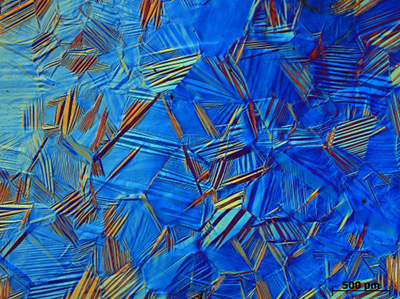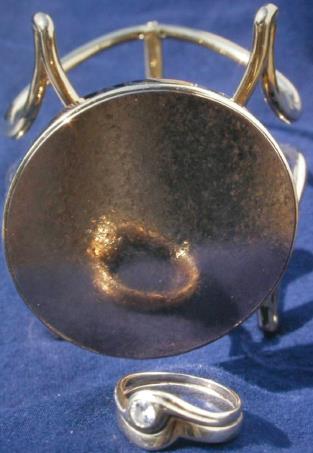Spangold Alloys
Abstract
Spangold alloys represent a groundbreaking advancement in precious metal technology, offering unique aesthetic characteristics that revolutionize jewelry manufacturing. These specialized shape memory alloys, available in 18 and 23 carat gold compositions, create distinctive multicolored spangled surfaces through controlled heat treatment. The remarkable visual effect results from a martensitic-type phase transformation that induces surface rumpling, causing light dispersion and creating an appealing aesthetic appearance. With a nominal composition of Au7Cu5Al4 (76% Au, 18% Cu, 6% Al by mass), Spangold alloys provide reversible transformation effects that penetrate throughout the bulk material rather than merely affecting the surface. Available in yellow and pink variations for both wrought and cast applications, these innovative alloys offer unprecedented decorative possibilities that cannot be replicated through conventional jewelry surface treatments.
Introduction to Spangold Alloys
Spangold alloys represent a relatively recent discovery that has established an exciting progression in aesthetic characteristics, particularly within the jewelry manufacturing sector. The distinctive visual effect generates through inducing a surface martensitic-type phase transformation, which disperses light to create a pleasing aesthetic appearance that captivates both designers and consumers.
Composition and Structure of Shape Memory Gold Alloys
While most commercial gold alloys currently contain additions of copper, silver, and zinc, Spangold represents a specialized family of shape memory alloys available in 18 and 23 carat gold compositions. Through controlled heat treatment, these innovative materials produce multicolored spangled surfaces that demonstrate optimal aesthetic effects on large flat or curved surfaces.
The spangle effect arises from surface rumpling caused by fundamental changes in crystal structure. However, this phenomenon extends beyond simple surface reactions, penetrating throughout the bulk alloy while maintaining complete reversibility. Available in both yellow and pink shades for wrought and cast applications, Spangold offers unprecedented effects that cannot be simulated through conventional jewelry surface treatments.
Figure 1 below shows a highly magnified view of the spangle effect with needle-shaped surface rumples.

Figure 1: Microstructure of Au7Cu5Al4 alloy
As a relatively new development, this innovative material is gradually being adopted by designers and manufacturers, though currently in limited applications.
Martensitic Phase Transformation in Jewelry Applications
Spangold functions as a β-phase alloy with nominal stoichiometry of Au7Cu5Al4 and composition of 76% Au, 18% Cu, 6% Al by mass. This Au7Cu5Al4 alloy serves as a decorative material that exhibits fine surface corrugation at room temperature, hence earning its distinctive "Spangold" designation.
The characteristic texture develops by inducing martensitic-type phase transformations within samples featuring polished surfaces. These transformations exhibit considerable crystallographic shear and deformation, causing previously flat surfaces to become faceted. The resulting facets disperse incident light, creating the desired aesthetic effect that defines Spangold's appeal.

Figure 2: The textured effect produced by a martensitic transformation on the planar surface of a Spangold 'tension bangle' is evident in the reflected image of the ring
Aesthetic Applications and Design Versatility
Spangold creates striking contrasts when positioned against conventional 18 carat gold and various other finishes including red-ivory wood, rhodium-plating, and precious stones. The vivid and stark contrast achieved through Spangold finishes provides eloquent testimony to the attractiveness of these specialized gold alloys.
The successful characterization of suitable transformation features enabled the development of prototype Spangold alloys. Beyond exploiting their novel finish capabilities, implementing prototype Spangold alloys in jewelry applications realizes practical applications of structural gold-base compounds in commercial settings.
Advanced Properties of Multicolored Spangled Surface Materials
Beyond their exceptional decorative qualities, Spangold alloys based on intermetallic compounds exhibit numerous salient features relevant to jewelry applications. These properties include enhanced density, superior luster, excellent castability, and improved wear-resistance characteristics that surpass traditional gold alloy performance.
These innovative gold compounds possess extensive and novel property ranges, positioning them for continued interest and development within the precious metals industry. The combination of aesthetic appeal and practical performance characteristics establishes Spangold alloys as significant contributors to advanced jewelry manufacturing techniques.
The reversible nature of the transformation effect ensures long-term durability while maintaining the distinctive visual characteristics that define Spangold's market appeal. This unique combination of beauty and functionality represents a significant advancement in precious metal technology, offering jewelry designers unprecedented creative possibilities while maintaining the traditional value and prestige associated with gold-based materials.
As research and development continue, Spangold alloys are expected to find broader applications across various jewelry categories, from high-end luxury pieces to innovative contemporary designs that showcase the material's distinctive spangled surface effects and superior performance characteristics.
Find Instantly Thousands of Metallography Diagrams!
Total Materia Horizon contains a unique collection of metallography images across a large range of metallic alloys, countries, standards and heat treatments.

Get a FREE test account at Total Materia Horizon and join a community of over 500,000 users from more than 120 countries.